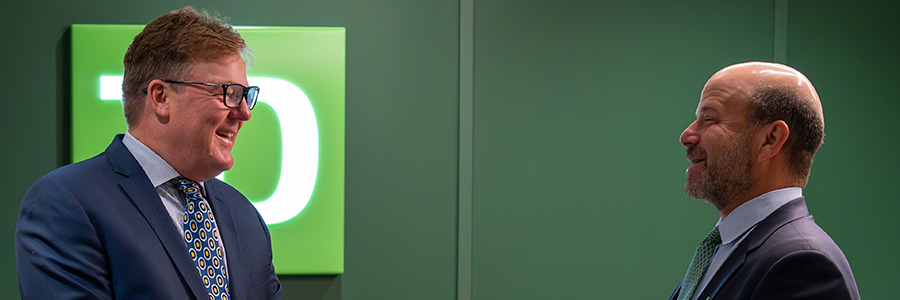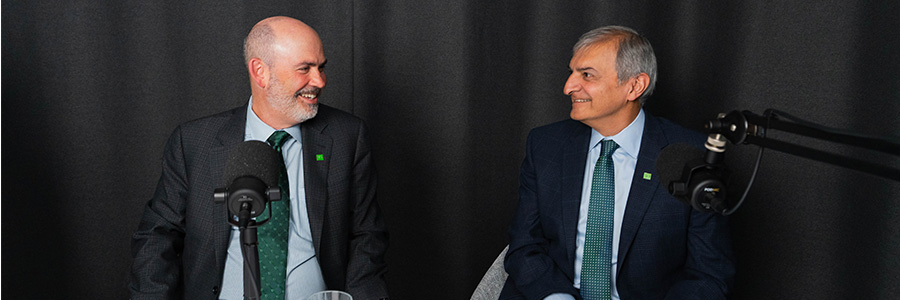Improving Human-Centric Banking with High-Tech Innovation
Guests: Kathryn Lamothe, Managing Director & Global Head of Trade Solutions, Product, Strategy and Risk, Global Transaction Banking, TD Securities
Host: Amy Van Arnhem, Managing Director and Head of Canada Senior Relationship Management, TD Securities
Balancing the needs for innovation and personal touch is key in modern transaction banking. Kathryn Lamothe and Elizabeth St-Onge sit down with host Amy Van Arnhem to provide an in-depth look at the modernization of transaction banking. We discuss the adoption of flexible, technology-driven solutions, opportunities for collaboration with FinTech startups and insights regarding the industry's evolution to meet future demands.
Listen to additional episodes for more perspectives from a variety of thought leaders on key themes influencing markets, industries and the global economy today.
This podcast was originally recorded on September 10, 2024.
ANNOUNCER: Welcome to Viewpoint, A TD Securities Podcast. Listen in as we draw perspectives from a variety of thought leaders on key themes influencing markets, industries, and the global economy today. We hope you enjoy this episode.
PETER HAYNES: Welcome to episode 33 of Viewpoint. My name is Peter Haynes. I'll be your host for today's podcast, where we will dig into some of the key themes impacting issuers in the corporate world. Our guest is TD Cowen's head of corporate Investment Banking, Larry Wieseneck. Larry, thanks for joining me today.
LARRY WIESENECK: Peter, thanks for having me. Pleasure.
PETER HAYNES: Before we dig in on some of the investment banking trends, I wanted to ask you about your first 18 months as part of TD Bank. You joined the bank as part of the TD Cowen merger. And the industrial logic was to bring together two firms and capital markets that had virtually no overlap and complementary assets, one with a balance sheet and mostly domestic Canadian presence, and the other with a global equities franchise. How has the integration gone to date? And what has been the reaction amongst the issuer community that you're speaking to about the merger?
LARRY WIESENECK: Well, Peter, first, thanks for asking about it since we've been so busy at work trying to bring the organizations together. I'll answer it in the order you raised it, which is, first, what we've accomplished and how we got here. And then secondly, how our issuers and clients have responded.
I think, on the first front, the value of the industrial logic wasn't lost on any of our people. And maybe I turn it to a positive. It was understood by all of our people. And that's really because of the great work that the leadership at TD in first thinking through the plan by having put together a playbook a few years earlier and then deciding to approach us. When I say us, I mean TD Cowen.
And then once we collectively agreed, it made sense and our board over at TD Cowen made the decision to do the transaction, there was a lot of work done with all of our employees to educate them on that industrial logic. So people went into this understanding the opportunity.
In terms of our clients, they understood. I think you laid out very succinctly the two primary issues, which was, you had an institution at Cowen that didn't have a balance sheet. And we had really gone to the limits of how we could service our clients. And we also were limited as to which clients we could serve, because there are so many clients where the key to their wallet is being a lender and being in their credit facility. And then it opens up the investment banking and corporate banking wallet.
And so we were limited from that standpoint, putting on the TD Securities hat, particularly in the US. But also when you get outside the US, other than Canada, without having an equity platform and a full complement of sectors, we, TDS, were also punching with one hand behind our back. And so by bringing the organization together, we've been able to really change the narrative with our clients. Those who've already worked with us before are beginning to now do multiple products with us, trust us more broadly.
But we've also opened up clients to the organization, both organizations that would never have fit for either one. But together with our collective strengths, we can now become important too. So it's early days, but it's been very, very warmly received by our clients.
PETER HAYNES: It's truly a 1 plus 1 equals 2 and 1/2 year. And I know we're all cheering for that outcome. Larry, when we think about the key themes in the investment banking world, you like to break it down into three main buckets, and I'm to work through them one by one to get your perspective on each of these issues.
And the first one is that capital dictates valuations, and in turn, who can raise money? Explain.
LARRY WIESENECK: I think it's important to recognize that when things are going really well, the market tends not to focus on one's capital position. They don't focus as much on what your term structure of your balance sheet is, et cetera.
But as soon as there's a wobble-- the wobble could be in the overall market. It could be a company misses their earnings. It could be that there's a downturn in someone's particular sector-- what becomes really important is how well capitalized you are.
Did you run your business on a financial leverage standpoint in a manner that was conservative, which gives you more room? Or did you run it at the extreme where you were more aggressive? And so if you think about it, if you have operating leverage, which is the ability to turn revenues into margin and then you throw in your operating leverage, you've got to be in sync.
And many companies find themselves in a position where they're not in sync. And so they're running with a lot of financial leverage on top of a lot of operating leverage. And that's a very risky place to be.
And so in that realm, if you think about what we've seen really the last two years, maybe up until six months ago, as we were in a rising interest rate environment, the companies that had precarious capital positions became very much at risk. And those who had conservative capital positions were, in many cases, in the catbird seat. They could decide to acquire weaker players. They could just take advantage of their competitor's relative weakness and expand organically by growing their sales force, whatever it might be. And if they had really good opportunities that came around, they could still go to their investors and raise more money.
The easiest version of that is the old colloquialism of there's haves and have nots. By having strong capital positions, they became haves. And that's true whether you're in the most established industries or you're in the extreme, in a growth industry with disruption, it's really important that you have a good capital base and a good relationship with your capital providers.
PETER HAYNES: OK, so as we move on here, your second theme is about disruptions. More specifically the point that a company is either a disruptor or is being disrupted.
LARRY WIESENECK: And I'm not sure whether I can say I coined that or not, but I started using it a lot in 2017, 2018 as we were developing our strategy back at TD Cowen for what we felt was an explosion of old industries becoming changed by technology. And there's the old saying, the software eats everything. And we were seeing that not just with software but also in the old school world, in industrials, in energy, et cetera. When you combine hardware with software and data, think now machine learning in terms of data, that all of a sudden there's new entrants that can take significant share from the old world.
So we started to say, we're not going to abandon the old economy, but the old economy is becoming new. And what that meant was you had to break down the players into where do you think there is a fee opportunity for a corporate investment bank.
And our view was that every single entity is on one side of that equation. You're either disrupting the status quo and thereby taking share, creating new markets, maybe even creating completely new products to service the end market. Or you're at risk of being disrupted.
And our biggest concern was-- this is as bankers-- it doesn't necessarily mean these companies won't stay around for a long time. But your best place to find opportunity for everything from M&A. It could be selling or buying, everything from who's going to need to raise capital is the disruptors. And the ones that understand they've been disrupted, if they don't make a move, are very, very good clients for an institution like ours. And certainly it was true when we were talking about independent TD Cowen.
The ones that you want to avoid are the ones that may be getting disrupted but don't recognize it. Because what ends up happening there is that they end up in a state of, quote unquote, "status" where they don't move. They don't make decisions. So, again, if you're sitting there thinking about how do we get the best return for our shareholders, the best return on our time, you want to be working with that barbell, those being disrupted because they're going to have to react and the disruptors. But importantly, they have to know they're being disrupted. It's not worth working with them if they don't know it.
PETER HAYNES: So I read all the time as I'm listening to your answer about how the financial institutions in our world or financial services companies are being disrupted. But I often wonder, are they the disruptors or are they being disrupted?
LARRY WIESENECK: That's a great question. Listen, I think financial services make for a really interesting case study because like ourselves, many players in the financial services world are regulated. And one thing about regulation, when you have a heavily regulated industry, it does mean at times that you, by definition, have to be slower to react because you have to make sure you're thinking about it through the lens of the regulatory framework. It often means that you need to really analyze things before you move in.
On the other hand, you get the benefit of the ring fence that a regulation provides you. There's certain activities that are very hard to penetrate as a non-regulated entity. And so I think that it's a great case study of most financial services firms at their core, even the large regulated entities, are technology players.
There's so much you think about any bank. Let's not use ourselves. Let's just use it could be JPMorgan or RBC take to our competitors, one Canadian, one American. The amount of spend that they have on technology and ops is huge. And so a small player can't afford that. And so there's lots of the business that therefore is going to continue to come to large players who have benefit of meeting the criteria for the regulators to allow them to operate with a license to operate.
On the other hand, there are parts of the business that are less regulated that are sometimes very high margin businesses that a quicker, more nimbler player can attach to. And that's where groups like challenger banks, a term that's maybe not in favor as much now but was five years ago, can play a significant role. You see in the credit card industry, new players emerge who basically come in and take share from some of the more larger established players.
I think the real interesting question for our industry, like other heavily regulated industries, is what percentage of the overall market continues to be dominated by the larger players? And I think that's really what the large financial situations, but I'd say the same thing is true in the regulated utility area, so in energy, where there's a limit to how much the independent players can do. They're very valuable. They play a role but ultimately often get bought by the larger regulated players as they've proven it out.
And so I think if you look at the history of the last four decades, what you find is a lot of the innovations come from outside of the regulated players. And then as they get to scale and they prove the market wants it, the regulated players then end up merging, buying, integrating the lessons learned. We're probably looking at in the next decade a similar theme.
What's important, though, is-- and I give a lot of credit to our team here, so now I'm going to make it personal, in technology and ops-- is always looking at what those developments are and deciding how can we incorporate some of those new technologies so that we don't get fully disrupted? We have to be thinking about the world as we're an established player, and we have an element of ourselves which also is a disruptor so that we incorporate those opportunities to get better.
PETER HAYNES: I think about the online do-it-yourself brokerage industry as you're talking about disruption and thinking about how that's one of the spaces where there's definitely been disruption both in the US and here in Canada. And the incumbents are reacting. They're changing their business models, and probably ultimately you think there'll be some M&A activity that will occur once the dust settles.
So the third theme can be summed up by the phrase, "uncool is cool again." What do you mean by this expression?
LARRY WIESENECK: I should maybe explain that for the listener. So in our prep discussions, we were talking about various themes, and I threw that out. In particular, I was talking about the semiconductor and the broader electronics space in technology where because of a lot of things, all happening at the same time, some of it being the onset of COVID and the implications of everyone being at home and the greater use of technology, which hasn't gone away.
So think how often we would have met in-person previously where now we replicate that by using Webex or Zoom or Teams. Now that's just one theme. But that was really jumping up in 2021, '22. But at the same token, the need to nearshore.
Supply chains became very, very difficult to keep intact. And the message, I think, across the world was that you needed to have a supply chain that was closer to home and was more dependent on like-minded countries because you couldn't rely on folks with very different systems. That led to in the semiconductor semi equipment space an explosion in the need to invest in and recognize first and then invest in having a much greater resilient supply chain of chips and throw in the explosion of machine learning and AI and the implication for data centers and chip manufacturers, et cetera.
What you see is old school infrastructure. The stuff that's not very sexy became really sexy. And you can look at our practice here where we've got a very vibrant business in data centers and all things digital infrastructure, same thing true for semi and semi equipment. And all of a sudden, the uncool is cool.
When you're recruiting on campuses now, students want to actually go into those spaces. No one a decade ago said, I'm really interested in fiber. I'm really interested in chips. And now they do because they recognize that it's critically important to our future, which is going to be all tech-enabled, that we have really deep infrastructure in all things that support that market.
So that's what I meant by that. And again, it goes back to the broader theme of there's enormous disruption happening in the old economy, and we want to be financing and supporting that change.
PETER HAYNES: So just as we finish up here, Larry, I want to ask you about the mood of the CEOs that you're speaking to. Other than geopolitical concerns, are there any common elements that are front and center in these discussions?
LARRY WIESENECK: We, as an organization, are, I think, somewhat lucky that we predominantly play in North America and Western Europe. And so we're talking to folks who, from a political landscape, share very similar traits.
Yes, some countries may be more pure capitalist than others, but they believe in capitalism. They believe in the rule of law and freedom. And I think that makes it a simpler conversation, because you start to hear echoes from folks. They're not on different sides of that issue.
And I think broadly, if you think about where there's worries, there's no question. There's some concerns about are we seeing some of the freedoms that people value? That's true, by the way, no matter what side of the political landscape they're on, that they might just see the risk to freedoms be slightly different. But I think they're worried about freedoms slipping because they view from a capitalist standpoint that freedom and capitalism go together.
And so they definitely worry about that. But that's passing. That's like the first minute of conversation.
And then they get to the more standard issues of they feel that certainly North America is an important area of economic strength and growth. So folks in the US and Canada, I think, benefit by being in North America and on a relative basis having much stronger economic growth opportunities ahead. And those who are in Europe view the opportunity in the US, in particular, as something that they have to invest more in.
So I was just in the UK and in Ireland. And every single company talked about how important building out more sales, in some cases, more manufacturing in North America was to their plans. And by the way, that was helpful for me because it allowed me to understand better how we, as TD, fit into their needs, because I think we're a very important partner for European players that are going to be growing in North America.
And so I would say for sure the theme of no one's excited in absolute terms about the economic landscape, but on a relative basis, there's a view that the US and Canada are in a much better position than much of the rest of the world. And that, I think, is good for both capital flows as well as for activity from a corporate investment banking standpoint. More folks continue to think about how do I grow in North America?
PETER HAYNES: Well, that's a good sort of bringing it all back to where we started here in terms of the industrial logic of the merger between TD Securities and TD Bank and Cowen was the fact that in Canada, every company is becoming global. Everywhere in the world companies are becoming global. And if you want to be provincial and think only within one jurisdiction, then you're probably going to be left behind.
So I'm not surprised to hear the feedback that you heard in Europe. And one of the key themes we're seeing in the world I live in is just that gravitational pull to the US capital markets. I think everybody needs to be a player. Some people are scared to step into that ocean, but the reality is it's 70% of the world. So I think you need to be there.
And welcome aboard to TD. I know it's been 18 months, but I hope you've enjoyed your time, and I hope it will be for a lot longer. Thanks, Larry, for joining us today.
LARRY WIESENECK: Thank you for having me. Appreciate it. Thank you.
ANNOUNCER: Thank you for listening to Viewpoint, A TD Securities Podcast. If you enjoyed this episode, subscribe to this series on Apple Podcasts or on your favorite podcast platform. For more thought leadership content, visit tdsecurities.com and follow us on LinkedIn for all the latest TD Securities updates. For relevant disclaimers to this podcast, please refer to the Viewpoint episode page on our website.
This podcast should not be copied, distributed, published or reproduced, in whole or in part. The information contained in this recording was obtained from publicly available sources, has not been independently verified by TD Securities, may not be current, and TD Securities has no obligation to provide any updates or changes. All price references and market forecasts are as of the date of recording. The views and opinions expressed in this podcast are not necessarily those of TD Securities and may differ from the views and opinions of other departments or divisions of TD Securities and its affiliates. TD Securities is not providing any financial, economic, legal, accounting, or tax advice or recommendations in this podcast. The information contained in this podcast does not constitute investment advice or an offer to buy or sell securities or any other product and should not be relied upon to evaluate any potential transaction. Neither TD Securities nor any of its affiliates makes any representation or warranty, express or implied, as to the accuracy or completeness of the statements or any information contained in this podcast and any liability therefore (including in respect of direct, indirect or consequential loss or damage) is expressly disclaimed.
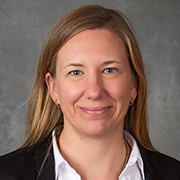
Managing Director & Global Head of Trade Solutions, Product, Strategy and Risk, Global Transaction Banking, TD Securities
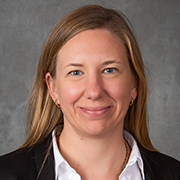
Kathryn Lamothe
Managing Director & Global Head of Trade Solutions, Product, Strategy and Risk, Global Transaction Banking, TD Securities

Kathryn Lamothe
Managing Director & Global Head of Trade Solutions, Product, Strategy and Risk, Global Transaction Banking, TD Securities
As Managing Director and Head of Global Trade Solutions, Kathryn leads the Global Trade Finance and Export Agency Finance businesses. Additionally, she leads the Product & Strategy and Risk Advisory teams that support all of Global Transaction Banking (GTB) businesses.
Kathryn has extensive treasury leadership experience across a business, product, and risk management perspectives. She enjoys driving transformational step change to deliver better solutions for clients that also drive sustainable business value for TD. Prior to joining GTB, Kathryn held various positions in Treasury and Balance Sheet Management and TD Securities Finance. She served as CFO for Corporate and Investment Banking and was responsible for the strategy and optimization of TD Securities’ liquidity.
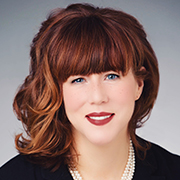
Managing Director, Head of Product Management, Global Transaction Banking, TD Securities
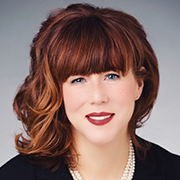
Elizabeth St-Onge
Managing Director, Head of Product Management, Global Transaction Banking, TD Securities

Elizabeth St-Onge
Managing Director, Head of Product Management, Global Transaction Banking, TD Securities
As Head of Product Management, Elizabeth leads Global Transaction Banking’s (GTB) engagement with clients to identify product needs and opportunities, commercialize new products, drive innovation and new capability development, and provide thought-leadership in the industry. She is a key driver of the product roadmap and ensuring the capabilities and solutions delivered to clients address needs and new market developments across all client segments and products. Elizabeth has over 20 years in the industry with leadership roles in corporate banking, transaction banking, and capital markets. She has deep expertise in treasury, payments, FX, trade finance, lending and liquidity management. Elizabeth has held numerous senior roles in the industry leading strategy, transformation and product management.
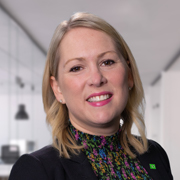
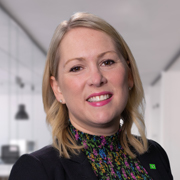
Amy Van Arnhem
Managing Director and Head of Canada Senior Relationship Management, TD Securities

Amy Van Arnhem
Managing Director and Head of Canada Senior Relationship Management, TD Securities
Amy is responsible for providing holistic cross product global coverage to senior executives for Canadian institutional clients. In her role she manages stakeholder relationships by promoting a collaborative and integrated approach across the firm. Joining our firm in 2001, Amy began her career at TD in the retail sector. In 2007, she joined the Sales and Trading rotational program at TD Securities where she gained exposure in Asset Securitization, Proprietary Equity, and Institutional Equities. In 2008, she joined the Institutional Equity Sales desk team where she covered Canadian equity clients.




